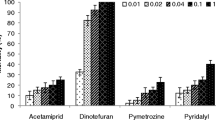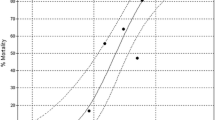Abstract
Morphological alterations, by means of histological and ultrastructural analysis, have been used to determine the effects of boric acid and fipronil on midgut tissues of honeybee worker, Apis mellifera L. larvae. In order to observe possible morphological alterations in the midgut, two groups of bioassays were performed. In the first one, the larvae were chronically treated with different concentrations of boric acid added to the food (1.0, 2.5 and 7.5 mg/g). In the second group, the larvae were fed with diets containing different concentrations of fipronil (0.1 and 1 μg/g) and compared with control groups without these chemical compounds. In the first bioassay, the larvae were collected on day 3 and in the second bioassay on day 4, when the mortality rate obtained in the toxicological bioassay was not very high. The larval midguts were removed and processed for morphological analyses using a light and transmission electron microscopy. We observed cytoplasmic vacuolizations, with the absence of autophagic vacuoles, and chromatinic compacting in most of the cells in the groups treated with pesticides. The morphological alterations were far greater in the larvae treated with boric acid than in the larvae treated with fipronil. Our data suggest that the midgut cell death observed was in response to boric acid and fipronil action. This study significantly improves the understanding of the toxicological effect of these insecticides from the ecotoxicological perspective.



Similar content being viewed by others
REFERENCES
Ali A, Nayar JK, Gu WD. Toxicity of a phenyl pyrazole insecticide, fipronil, to mosquito and chironomid midge larvae in the laboratory. J Am Mosq Control Assoc. 1998;14(2):216–8.
Babendreier D, Kalberer N, Romeis J, Fluri P, Bigler F. Pollen consumption in honey bee larvae: a step forward in the risk assessment of transgenic plants. Apidologie. 2004;35:293–300.
Balanca G, Visscher M. Impacts on non-target insects of a new insecticide compound used against the desert locust [Schistocerca gregaria (Forskal 1775)]. Environ Contam Toxicol. 1997;32:58–62.
Bloomquist JR. Chloride channels as tools for developing selective insecticides. Arch Insect Biochem Physiol. 2003;54(4):145–56.
Buckingham SD, Biggin PC, Sattelle BM, Brown LA, Sattelle DB. Insect GABA receptors: splicing, editing, and targeting by antiparasitics and insecticides. Mol Pharmacol. 2005;68(4):942–51.
Caetano FH, Torres AHJ, Mathias MIC, Tomotake MEM. Apocrine secretion in the ant, Pachycondyla striata, ventriculus (Formicidae: Ponerinae). Cytobios. 1994;80:235–42.
Cavalcante VM, Cruz-Landim C. Types of cells present in the midgut of the insects: A review. Naturalia. 1999;24:19–40.
Chandler GT, Cary TL, Volz DC, Walse SS, Ferry JL, Klosterhaus SL. Fipronil effects on estuarine copepod (Amphiascus tenuiremis) development, fertility, and reproduction: a rapid life-cycle assay in 96-well microplate format. Environ Toxicol Chem. 2004;23(1):117–24.
Chauzat MP, Faucon JP, Martel AC, Lachaize J, Cougoule N, Aubert M. A survey of Pesticide Residues in Pollen Loads by Honeybees in France. J Econ Entomol. 2006;99:253–62.
Cochran DG. Toxic effects of boric acid on the German cockroach. Cell Mol Life Sci. 1995;51:561–4.
Cruz-Landim C, Cavalcante VM. Ultraestructural and cytochemical aspects of metamorphosis in the midgut of Apis mellifera L. (Hymenoptera: Apidae: Apinae). Zool Sci. 2003;20:1099–107.
Cruz-Landim C, Melo RA. Desenvolvimento e Envelhecimento de larvas e adultos de Scaptotrigona postica latreille (Hymenoptera, Apidae): aspectos histológicos e histoquímicos. São Paulo: ACIESP; 1981: 118pp.
Cruz-Landim, C. Biologia do desenvolvimento em abelhas. Departamento de Biologia, Instituto de Biociências, UNESP – Rio Claro, 2004. In: <http://www.rc.unesp.br/ib/biologia/carminda.html>. Access: Oct. 09 2007.
Dai JD, Gilbert LI. Programmed cell death of the prothoracic glands of Manduca sexta during pupal-adult metamorphosis. Insect Biochem Molec Biol. 1997;27(1):69–78.
Devillers J, Pham-Delègue M. Honey bees: Estimating the environmental impact of chemicals. New York: Taylor and Francis Inc; 2002: 332p.
Durmus Y, Büyükgüzel K. Biological and Immune Response of Galleria mellonella (Lepidoptera: Pyralidae) to Sodium Tetraborate. J Econ Entomol. 2008;101(3):777–83.
Dzitoyeva S, Gutnov A, Imbesi M, Dimitrijevic N, Manev H. Developmental role of GABAB(1) receptors in Drosophila. Dev Brain Res. 2005;158(1–2):111–4.
Ebelin W, Reierson DA, Pence RJ, Viray MS. Silica aerogel and boric acid against cockroaches: external and internal action. Pestic Biochem Physiol. 1975;5:81–9.
Enell L, Hamasaka Y, Kolodziejczyk A, Nässel DR. Gamma-aminobutyric acid (GABA) signaling components in Drosophila: Immunocytochemical localization of GABA(B) receptors in relation to the GABA(A) receptor subunit RDL and a vesicular GABA transporter. J Comp Neurol. 2007;505(1):18–31.
Gregorc S, Bowen ID. Programmed cell death in honeybee (Apis mellifera) larvae midgut. Cell Biol Int. 1996;21:151–8.
Gregorc A, Bowen ID. Programmed cell death in the honey-bee (Apis mellifera L.) larvae midgut. Cell Biol Int. 1997;21(3):151–58.
Gregorc S, Bowen ID. Histopatological and histochemical changes in honeybee larvae (Apis mellifera L.) after infection with Bacillus larvae, the causative agent of American foulbrood disease. Cell Biol Int. 1998;22(2):137–44.
Gregorc A, Bowen ID. In situ localization of heat-shock and histone proteins in honeybee (Apis mellifera L.) larvae infected with Paenibacillus larvae. Cell Biol Int. 1999;23(3):211–18.
Gregorc A, Bowen ID. Histochemical characterization of cell death in honeybee larvae midgut after treatment with Paenibacillus larvae, Amitraz and Oxytetracycline. Cell Biol Int. 2000;24(5):319–24.
Gregorc S, Smodis-Skerl MI. Toxicological and immunohistochemical testing of honeybees after oxalica acid and rotenone treatments. Apidologie. 2007;38:296–305.
Guimarães M. Colméias às moscas: síndrome misteriosa causa sumiço de abelhas na América e Europa. Pesquisa FAPESP. 2007; 137.
Habes D, Morakchi S, Aribi N, Farine J-P, Soltani N. Boric acid toxicity to the German cockroach, Blattella germenica: Alterations in midgut structure, and acetylcholinestrease and glutathione S- transferase activity. Pestic Biochem Physiol. 2006;84:17–24.
Häcker G. The morphology of apoptosis. Cell Tissue Res. 2000;301:5–17.
Hyrsl P, Buyükgüzel E, Büyükgüzel K. The effects of boric acid-induced oxidative stress on antioxidant enzymes and survivorship in Galleria mellonella. Arch Insect Biochem. 2007;66:23–31.
Jesus D, Silva-Zacarin ECM, Malaspina O. Histological studies in the midgut and Malpighian tubules of Apis mellifera workers treated with boric acid. Braz J Morphol Sci. 2005; Suppl: 168.
Kerr JF, Wyllie AH, Currie AR. Apoptosis: a basic biological phenomenon with wide ranging implications in tissue kinetics. Br J Cancer. 1972;26:239–57.
Klotz JH, Amrhein C, McDaniel S, Rust MK, Reierson DA. Assimilation and toxicity of boron in the Argentine ant (Hymenoptera: Formicidae). J Entomol Sci. 2002;37(2):193–9.
Lockshin RA, Beaulaton J. Programmed cell death. Cytochemical evidence for lysosomes during the normal breakdown of the intersegmental muscles. J Ultrastruct Res. 1974;46:43–62.
Malaspina O, Silva-Zacarin ECM. Cell markers for ecotoxicological studies in target organs of bees. Braz J Morphol Sci. 2006;23:303–9.
Malone LA, Tregidga EL, Todd JH, Burgess EPJ, Philip BA, Markwick NP, et al. Effects of ingestion of a biotin-binding protein on adult and larval honey bees. Apidologie. 2002;33:447–58.
Martins GF, Neves CA, Campos LAO, Serrão JE. The regenerative cells during the metamorphosis in the midgut of bees. Micron. 2006;37:161–8.
Morse RA, Calderone NW. The value of honeybees as pollinators of U.S. crops in 2000. Bee Culture. 2000;128:1–15.
National Pesticide Telecommunications Network. (2006) Boric acid (Technical fact sheet). In: <http://npic.orst.edu/factsheets/borictech.pdf>. Access: Nov. 28 2006.
Proskuryakov SY, Konoplyannikov AG, Gabai VL. Necrosis: a specific form of programmed cell death? Exp Cell Res. 2002;283:1–16.
Rhône-Poulenc. Atelier International Fipronil/lutte antiacidienne. Unpublished report. Rhône-Poulenc Agrochimie, Lyon, France. 1995
Silva de Moraes RLM, Bowen ID. Modes of cell death in the hypopharyngeal gland of the honey bee (Apis mellifera L.). Cell Biol Int. 2000;24(10):737–43.
Silva-Zacarin ECM. Authophagy and Apoptosis coordinate physiological cell death in larval salivary glands of Apis mellifera (Hymenoptera: Apidae). Autophagy. 2007;3:516–8.
Silva-Zacarin ECM, Taboga SR, de Moraes RLM Silva. Nuclear alterations associated to programmed cell death in larval salivary glands. Micron (Oxford). 2008;39(Silva de Moraes RLM):117–27.
Silva-Zacarin ECM, Tomaino GA, Brocheto-Braga MR, Taboga SR, de Silva Moraes RLM. Programmed cell death in the larval salivary glands of Apis mellifera (Hymenoptera, Apidae. J Biosci. 2007;32:309–28.
Snodgrass RE. Anatomy of honeybee. New York: Cornell University Press. 1956; 334pp.
Sorour J. Ultrastructural variations in Lethocerus niloticum (Insecta: Hemiptera) caused by pollution in Lake Mariut, Alexandria, Egypt. Ecotoxicol. Environ. Saf. 2001;48:268–74.
Thiboldeaux RL, Lindroth RL, Tracy JW. Effects of juglone (5-hydroxy-1, 4-naphthoquinone) on midgut morphology and glutathione status in Saturniid moth larvae. Comp Biochem Physiol Part C Pharmacol Toxicol Endocrinol. 1998;120(3):481–7.
Tingle CC, Rother JA, Dewhurst CF, Lauer S, King WJ. Fipronil: environmental fate, ecotoxicology, and human health concerns. Environ Contam Toxicol. 2003;176:1–66.
Ulloa-Chacón P, Jaramillo GI. Effects of boric acid, fipronil, hydramethylnon, and diflubenzuron baits on colonies of ghost ants (Hymenoptera: Formicidae). J Econ Entomol. 2003;96:856–62.
Wegerhoff R. GABA and serotonin immunoreactivity during postembryonic brain development in the beetle Tenebrio molitor. Microsc Res Tech. 1999;45(3):154–64.
Xue RD, Ali A, Kline DL, Barnard DR. Field evaluation of boric acid- and fipronil-based bait stations against adult mosquitoes. J Am Mosq Control Assoc. 2008;24(3):415–8.
Xue RD, Barnard DR. Boric acid bait kills adult mosquitoes (Diptera: Culicidae). J Econ Entomol. 2003;96(5):1559–62.
Xue RD, Kline DL, Ali A, Barnard DR. Application of boric acid baits to plant foliage for adult mosquito control. J Am Mosq Control Assoc. 2006;22(3):497–500.
Acknowledgements
We thank CNPq for the financial support and the Department of Biology at UNESP-Rio Claro for the technical support.
Author information
Authors and Affiliations
Corresponding author
Rights and permissions
About this article
Cite this article
da Silva Cruz, A., da Silva-Zacarin, E.C.M., Bueno, O.C. et al. Morphological alterations induced by boric acid and fipronil in the midgut of worker honeybee (Apis mellifera L.) larvae. Cell Biol Toxicol 26, 165–176 (2010). https://doi.org/10.1007/s10565-009-9126-x
Received:
Accepted:
Published:
Issue Date:
DOI: https://doi.org/10.1007/s10565-009-9126-x




